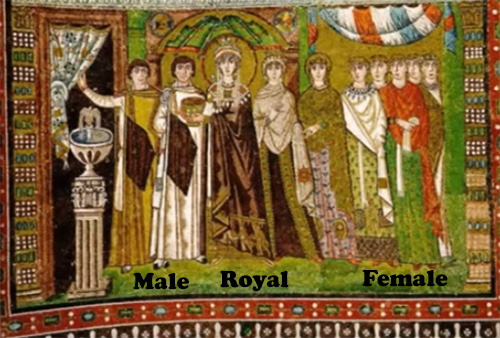 The traditional outfit in the Byzantine Empire (395-1453) was very similar to the Roman clothing (the Roman Empire). But there are some peculiarities and unique fashion trends introduced by the Byzantine people. Let’s find out how a Byzantine traditional costume looked like? what garments were there? what decorations and adornments did they use? what did the Byzantine royal family wear? The Byzantine traditional attire is interesting because it is used by a lot of people even today. By whom? You’ll find that info below.
The traditional outfit in the Byzantine Empire (395-1453) was very similar to the Roman clothing (the Roman Empire). But there are some peculiarities and unique fashion trends introduced by the Byzantine people. Let’s find out how a Byzantine traditional costume looked like? what garments were there? what decorations and adornments did they use? what did the Byzantine royal family wear? The Byzantine traditional attire is interesting because it is used by a lot of people even today. By whom? You’ll find that info below.
The article is based on a video by Amanda Hallay, fashion historian
Read also:
Byzantine female attire in detail
Byzantine crowns with pendilia or temple pendants – artful jewelry or imperial symbol of power?
Byzantine imperial dress. What did Byzantine emperors wear?
A Byzantine costume has its foundation in the Roman attire. But it is worked very differently. The Silk Road was at its absolute height during this era, and so the Byzantine Empire, which was prosperous – for the wealthy, for the imperial family, and the higher-ups – was marked by silk, by embroidery, by jewels. The Byzantine clothing was very sumptuous compared to a Roman attire, which was much more pared down. Though, the elements are in place: the tunic, the palla, the stola. Let's take a look and see what the Byzantine Empire did with all this stuff.

Men’s clothing in the Byzantine Empire
First, there’s a tunica. Both men and women wore tunicas (also known in this era as “chiton”) beneath the rest of their clothing; men’s were calf-length and women's were full-length.
But here is a new item – the “dalmatica”. It was an A-line tunic with split subsides; for the elite, it was embroidered or trimmed with jewels.
By the way, a lot of what we find in Byzantine costume is actually still worn today, very much in its original form, by the clergy. Priests, for example, wear dalmaticas when they are giving a special service.
Women’s clothing in the Byzantine Empire
Here, we have the palla and the stola. They are still in play. Just like in ancient Rome, women wore tunicas, pallas, and stolas, but in Byzantium (for the upper classes), both the pallas and stolas were made of sumptuous, colorful textiles, often embroidered, and sometimes bejeweled.
Clothing of the royal family in the Byzantine Empire
They wore a collar called a “superhumeral”. Only worn by the royals, the superhumeral was a large, heavily jeweled collar worn by both genders.
The Byzantine crown is called a “loros” or a “pallium”. And on a female pallium, there are strings of pearls and jewels hanging in 2 or 3 rows from it at the front.
The Byzantine costume was a sight to behold, the eye was dazzled by it – and this was the whole point. We really see costume being used as status here.
Read also:
Byzantine female attire in detail
Byzantine crowns with pendilia or temple pendants – artful jewelry or imperial symbol of power?
Byzantine imperial dress. What did Byzantine emperors wear?
(c)


